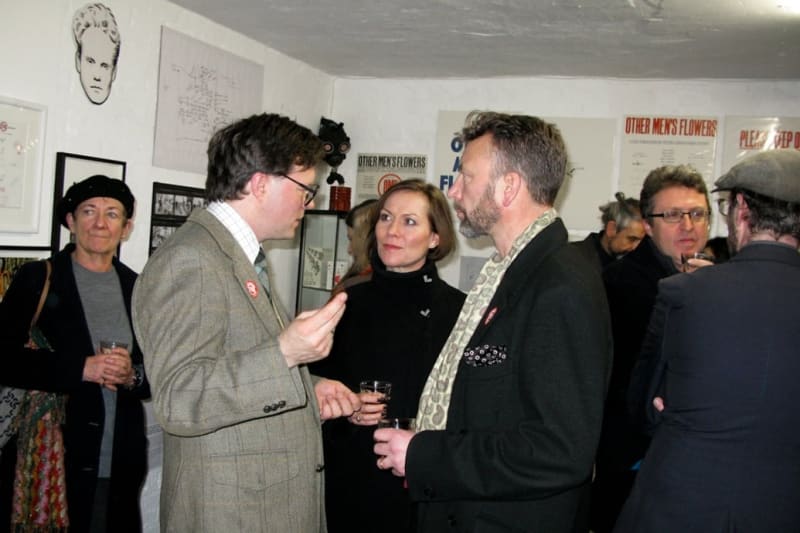Emin had a kissing tent. Gary Hume dressed as a Mexican dandy and sold tequila slammers. Fairhurst and Hirst wore clown costumes, got drunk, and ruined their outfits while making spin paintings. Hirst describes the scene in Coffield’s Factual Nonsense, saying, “Leigh Bowery did our make up and painted our cocks and bollocks. I had spots painted on mine and we charged 50 pence for a spin painting and 50 pence to see our bollocks. We made more money off the bollocks.” According to others, the paintings went for a pound each, and the book is not short of former fair-goers lamenting that their spins somehow went missing.
The Fete Worse Than Death was an organizational disaster and a massive success. The Fete Worse Than Death II, the following summer, was more put together and even more successful, but Compston, a prolific ideas man with negative money managing skills, contrived to lose dough on both.
Hanging Picnic of 1995, Compston’s next public outing, was inspired by a commonplace London scene: kitschy artworks being sold off the park railings down the road from the Ritz Hotel. This time, Compston corralled 27 artists, including Gavin Turk, Gary Hume, Tracey Emin, Tim Noble, and Sue Webster, future art stars all, to participate, and London Weekend Television (LWT) made a documentary of the event. Coffield notes that LWT did not fork over any dough for Compston’s pains.
I could go on. Compston had innovative ideas a-plenty. Es la Manera was a show of...stuff. Nowadays, everybody is doing shows of stuff. Back then, no one was. He enlisted Gavin Turk to help design the Utopic Space Manifest, an inflatable mobile museum, kind of an art circus. Turk came up with a design modeled on lozenge-shaped chewing-gum. “It did not get made due to lack of financing but then Frieze went and did it, which is annoying!” Aurel Scheibler, the Cologne dealer, observed.
Compston conceived of ventures on the edge where art meets life, such as boxing matches. This too was a still-born, but the extreme performance artist David Lesley would later put on box opera in New York. In 1994, Compston named himself the chairman of FN Holdings—Factual Nonsense—with which he planned in a not-at-all-explained way to manage creative real estate. “The FN butcher, the FN baker, and the FN candlestick maker,” he wrote. He dreamed up “Nonsense Clubs.” Carsten Holler’s Double Club, which was both an artwork and an operating nightclub, opened behind the Angel subway station, London, in 2008.
There was a dark side to him too. Very dark. Compston was a self-harmer. “Joshua was quite dangerous,” Coffield says. “He would turn up at private views with distress flares and sticks of dynamite and stuff.” He threw himself off a balcony. He held a cake knife to his throat at his birthday party in the Colony Room, and the friend who tried to disarm him had to get 36 stitches. Around the time he died, somebody tried to deliver him dynamite with which he planned to blow up a chunk of public art he hated, a monument to Alfred Hitchcock on Leonard Street. He wrote of wanting to “torch the art world.”
Just before his death, Compston said that he was fearful of being imprisoned for debt. The last show he planned was to be of artist-designed coffins, Jay Jopling, who had opened the first White Cube in Mayfair in 1993, supported it. But Gary Hume notes that this words-addict improbably left no Last Words. No wonder those close to him differ on whether his death was a classic overdose, a suicide, or a death-daring performance that just went too far. The packed funeral was at a Hawksmoor church close to Gilbert and George’s house. Gary Hume and Gavin Turk painted his coffin with a design by one of his heroes, the art utopian, William Morris, and the pallbearers included Gary Hume, Gavin Turk, Aurel Scheibler, Eric Franck, and Jay Jopling.
And now, 18 years later, how much awareness of Joshua Compston is there in the London art world?
“Absolutely none,” Coffield says. “Absolutely none. It’s quite strange how what he did has been completely glossed over.”
Joshua Compston was not blessed with diplomatic skills, Coffield notes. “Joshua didn’t really get on with Saatchi. He wouldn’t play Saatchi’s game. And, of course, all these people had to kowtow and sell to Saatchi. People might want to seem avant-garde and stuff. But they aren’t.”
It wasn’t just Saatchi though.
“I found him quite irritating,” says James Birch. It was Birch who took Gilbert and George to China, a trip on which Compston was invited, missed the plane, and came along later. “I said there’s no point in talking to me,” Birch adds. “I really found him sort of annoying. He’s like a mosquito. He never left people alone.”
Damian Hirst has also said he found him annoying, that he was always asking for things. Jeremy Deller was one of a lengthy list of artists who refused to talk about Compston at all.\
There’s something else. The artist Simon Bill observed to Coffield that “there’s a kind of Alzheimer’s the art world has. It’s got a bit like the fashion industry in that it can only survive by continually forgetting things, so that everything looks new all the time.” This is particularly true of an art impresario who dealt in ideas and ephemera with mixed success, especially in an art world unready for them. Too early is too early. All true. But the art world is also terrific at recycling when it has sufficiently rich material to work with, however difficult that material may be. Or especially when it is difficult. Joshua Compston was part of the narrative. It’s time to give him his due.
